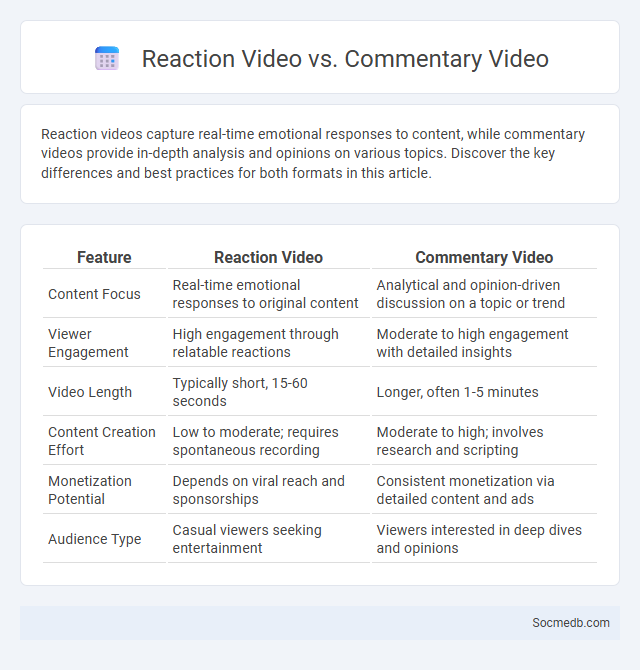
Photo illustration: Reaction Video vs Commentary Video
Reaction videos capture real-time emotional responses to content, while commentary videos provide in-depth analysis and opinions on various topics. Discover the key differences and best practices for both formats in this article.
Table of Comparison
| Feature | Reaction Video | Commentary Video |
|---|---|---|
| Content Focus | Real-time emotional responses to original content | Analytical and opinion-driven discussion on a topic or trend |
| Viewer Engagement | High engagement through relatable reactions | Moderate to high engagement with detailed insights |
| Video Length | Typically short, 15-60 seconds | Longer, often 1-5 minutes |
| Content Creation Effort | Low to moderate; requires spontaneous recording | Moderate to high; involves research and scripting |
| Monetization Potential | Depends on viral reach and sponsorships | Consistent monetization via detailed content and ads |
| Audience Type | Casual viewers seeking entertainment | Viewers interested in deep dives and opinions |
Understanding Reaction Videos: Definition and Purpose
Reaction videos are a popular social media content format where creators film their genuine responses to various media such as music, movies, or viral clips, offering viewers an authentic and relatable experience. These videos serve the purpose of building community engagement by encouraging shared emotions and discussions, often boosting visibility and subscriber growth on platforms like YouTube and TikTok. Understanding the psychological appeal behind reaction videos helps brands and influencers leverage this trend to enhance audience connection and content virality.
Commentary Videos Explained: Key Features and Differences
Commentary videos on social media combine personal opinions and analyses with trending topics, often integrating humor, critique, or storytelling to engage audiences. Key features include a clear narrative voice, visually enhanced content such as clips or images, and a strong emphasis on authenticity to build viewer trust. Differences among platforms hinge on format preferences, such as YouTube's longer, in-depth videos versus TikTok's short, snappy clips, impacting how creators tailor their commentary style and pacing.
Reaction Video vs Commentary Video: Core Distinctions
Reaction videos capture your immediate emotional response by showcasing genuine, spontaneous expressions while watching original content, creating a sense of authenticity and connection with viewers. Commentary videos provide in-depth analysis, critiques, or opinions, often structured and researched to offer insights or provoke thought. Each format serves a different audience purpose: reactions emphasize relatability and entertainment, whereas commentaries prioritize information and engagement through detailed discussion.
Types of Reaction Videos: Formats and Styles
Reaction videos come in various formats and styles, including live reactions, compilation reactions, and commentary-driven responses. Popular types include genuine emotional reactions, comedic interpretations, and analytical breakdowns, each catering to different audience preferences. Your choice of format influences viewer engagement and the overall impact of your content on social media platforms.
The Rise of Commentary Videos in Digital Media
The rise of commentary videos has transformed digital media by enabling creators to analyze and critique trends, news, and entertainment on platforms like YouTube and TikTok. These videos attract diverse audiences by fostering engagement through personal insights and community discussions, boosting viewership and algorithmic visibility. Your participation in this trend can amplify your social media presence by tapping into niche interests and leveraging real-time cultural conversations.
Audience Engagement: How Viewers Interact with Each Format
Audience engagement on social media varies significantly by content format, with video posts achieving average engagement rates up to 6.15%, outperforming image and text-based content. Interactive features such as polls, stories, and live streams boost viewer participation and retention by fostering real-time connections and feedback. Tailoring content to platform-specific preferences, like short-form videos on TikTok versus in-depth articles on LinkedIn, maximizes user interaction and shares.
Content Creation Strategies: Reaction vs Commentary
Content creation strategies on social media often revolve around reaction and commentary styles, each serving distinct purposes in audience engagement. Reaction content captures immediate emotional responses, driving high engagement through relatability and spontaneity, while commentary offers deeper analysis and personal insights, fostering thought leadership and building trust with Your followers. Choosing between reaction and commentary depends on Your brand voice, objectives, and the type of connection you aim to establish with your audience.
Popular Platforms for Reaction and Commentary Videos
TikTok, YouTube, and Instagram dominate as popular platforms for reaction and commentary videos due to their extensive reach and user engagement features. Your content can gain significant traction through YouTube's comprehensive monetization options and TikTok's algorithm-driven discovery system. Instagram's IGTV and Reels provide dynamic formats that boost visibility and interaction within niche communities.
Legal and Ethical Considerations in Reaction and Commentary Videos
Reaction and commentary videos on social media must navigate copyright laws and fair use policies to avoid infringement claims, ensuring original content and transformative commentary. Creators should respect privacy rights and avoid defamation by presenting accurate, non-misleading information and obtaining necessary permissions when featuring individuals. Ethical considerations include transparency about endorsements, avoiding harmful stereotypes, and fostering respectful discourse to maintain audience trust and platform integrity.
Future Trends: The Evolution of Reaction and Commentary Videos
Reaction and commentary videos are evolving with advancements in AI and immersive technologies, offering more personalized and interactive viewer experiences. You will see augmented reality integrations that allow real-time viewer feedback and deeper emotional engagement, transforming passive watching into active participation. These trends will redefine social media content consumption, making reactions more authentic, data-driven, and community-centric.
 socmedb.com
socmedb.com